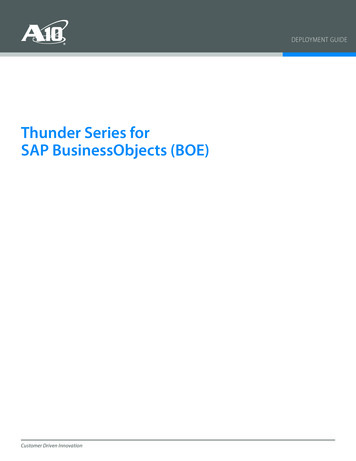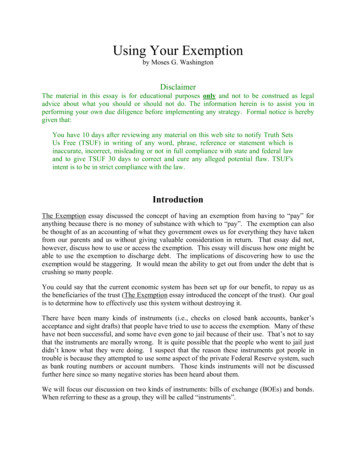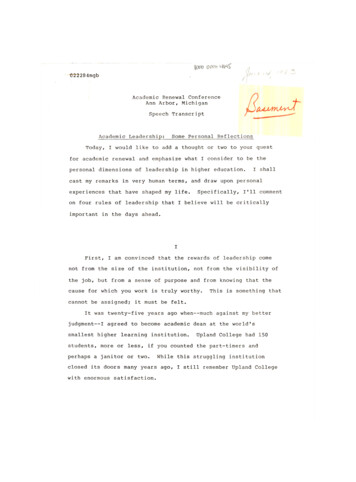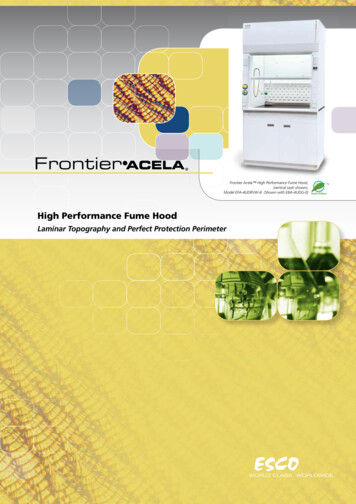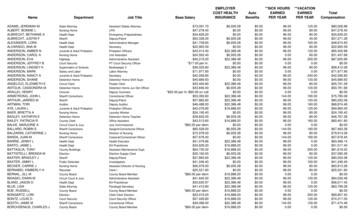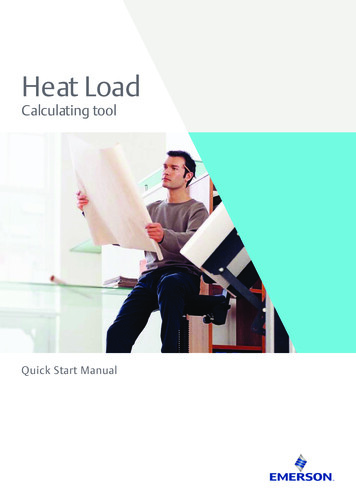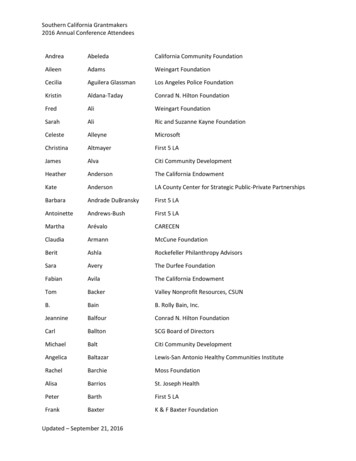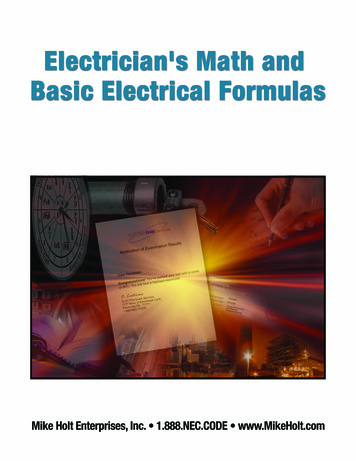
Transcription
tEnterprises,Inc. 1.888.NEC.CODE www.MikeHolt.com
IntroductionIntroductionThis PDF is a free resource from Mike Holt Enterprises,Inc. It’s Unit 1 from the Electrical NEC Exam Preparationtextbook. It is always our pleasure to give back to theindustry as much as we can. Enjoy!About the AuthorMike Holt worked his way up through the electrical tradefrom an apprentice electrician to become one of the mostrecognized experts in the world as it relates to electricalpower installation. He was a Journeyman Electrician, MasterElectrician, and Electrical Contractor. Mike came fromthe real world, and his dedication to electrical training isthe result of his own struggles as an electrician looking fora program that would help him succeed in this challengingindustry.It is for reasons like this that Mike continues to help theindustry by providing free resources such as this document.It is the goal of Mike Holt and everyone on the Mike HoltTeam to do everything in our power to aid in your pursuit ofexcellence.About this Free PDFThis Free Unit was extractedfrom Mike’s Electrical NEC ExamPreparation textbook which is why youwill notice that this pdf starts with page3. To fully prepare for your NationalElectrical Code exam you need tostudy the entire Electrical NEC ExamPreparation textbook.Most electrical exams contain questions on electrical theory, basic electrical calculations,the Code, and important and difficult National ElectricalCode Calculations. The Electrical NEC Exam Preparationtextbook contains hundreds of illustrations, examples,almost 3,200 practice questions covering all of these subjects and 36 practice quizzes. This book is intended to beused with the 2008 National Electrical Code.For more great Free resources from Mike Holt visitwww.MikeHolt.comMike Holt Enterprises, Inc. www.MikeHolt.com 1.888.NEC.CODEiii
UNIT1Electrician’sMath and BasicElectrical FormulasIntroductionIn order to construct a building that will last into the future,a strong foundation is a prerequisite. The foundation is a partof the building that is not visible in the finished structure, butis extremely essential in erecting a building that will have thenecessary strength to endure.The math and basic electrical concepts of this unit are verysimilar to the foundation of a building. The concepts inthis unit are the essential basics that you must understand,because you will build upon them as you study electrical circuits and systems. As your studies continue, you’ll find that agood foundation in electrical theory and math will help youunderstand why the NEC contains certain provisions.This unit includes math, electrical fundamentals, and anexplanation of the operation of electrical meters to help youvisualize some practical applications. You’ll be amazed athow often your electrical studies return to the basics of thisunit. Ohm’s law and the electrical formulas related to it, arethe foundation of all electrical circuits.Every student begins at a different level of understanding,and you may find this unit an easy review, or you may findit requires a high level of concentration. In any case, be certain that you fully understand the concepts of this unit andare able to successfully complete the questions at the end ofthe unit before going on. A solid foundation will help in yoursuccessful study of the rest of this book.Part A—Electrician’s Math1.0 IntroductionNumbers can take different forms:Whole numbers: 1, 20, 300, 4,000, 5,000Decimals: 0.80, 1.25, 0.75, 1.15Fractions: 1/2, 1/4, 5/8, 4/3Percentages: 80%, 125%, 250%, 500%You’ll need to be able to convert these numbers from one formto another and back again, because all of these number formsare part of electrical work and electrical calculations.You’ll also need to be able to do some basic algebra. Manypeople have a fear of algebra, but as you work through thematerial here you will see there is nothing to fear but fearitself.1.1 Whole NumbersWhole numbers are exactly what the term implies. These numbers do not contain any fractions, decimals, or percentages.Another name for whole numbers is “integers.”1.2 DecimalsThe decimal method is used to display numbers other thanwhole numbers, fractions or percentages, such as, 0.80, 1.25,1.732, etc.1.3 FractionsA fraction represents part of a whole number. If you use a calculator for adding, dividing, subtracting, or multiplying, youneed to convert the fraction to a decimal or whole number.Mike Holt Enterprises, Inc. www.MikeHolt.com 1.888.NEC.CODE
Chapter 1Electrical TheoryTo change a fraction to a decimal or whole number, dividethe numerator (top number) by the denominator (bottomnumber).Examples:c1/6 one divided by six 0.1662/5 two divided by five 0.403/6 three divided by six 0.505/4 five divided by four 1.257/2 seven divided by two 3.501.5 MultiplierWhen a number needs to be changed by multiplying it by apercentage, this percentage is called a multiplier. The first stepis to convert the percentage to a decimal, then multiply theoriginal number by the decimal value.cExample AAn overcurrent protection device (circuit breaker or fuse)must be sized no less than 125 percent of the continuous load.If the load is 80A, the overcurrent protection device will haveto be sized no smaller than . Figure 1–21.4 Percentages(a) 80AA percentage is another method used to display a value. Onehundred percent (100%) means all of the value; fifty percent(50%) means one-half of a value, and twenty-five percent(25%) means one-fourth of a value.(b) 100A(c) 125A(d) 75A Answer: (b) 100AStep 1: Convert 125 percent to a decimal: 1.25Step 2: Multiply the value 80 by 1.25 100AFor convenience in multiplying or dividing by a percentage,convert the percentage value to a whole number or decimal,and then use this value for the calculation. When changing apercent value to a decimal or whole number, drop the percentage symbol and move the decimal point two places to the left.Figure 1–1Figure 1–2Figure 1–1ExamplescPercentage32.50%80%125%250% Number0.3250.801.252.50cExample BThe maximum continuous load on an overcurrent protectiondevice is limited to 80 percent of the device rating. If the protective device is rated 50A, what is the maximum continuousload permitted on the protective device? Figure 1–3(a) 40A(b) 50A(c) 75A(d) 100A Answer: (a) 40AStep 1: Convert 80 percent to a decimal: 0.80Step 2: Multiply the value 50A by 0.80 40AMike Holt’s Illustrated Guide to Electrical NEC Exam Preparation
Electrician’s Math and Basic Electrical FormulasUnit 1Step 2: Add one to the decimal: 1 0.15 1.15Step 3: Multiply 8 by the multiplier 1.15: 8 kW x 1.15 9.20 kWFigure 1–31.6 Percent IncreaseFigure 1–4The following steps accomplish increasing a number by aspecific percentage:Step 1:Convert the percent to a decimal value.Step 2:Add one to the decimal value to create the multiplier.Step 3:cMultiply the original number by the multiplier foundin Step 2.Example AIncrease the whole number 45 by 35 percent.1.7 ReciprocalsTo obtain the reciprocal of a number, convert the numberinto a fraction with the number one as the numerator (topnumber). It is also possible to calculate the reciprocal of adecimal number. Determine the reciprocal of a decimalnumber by following these steps:Step 1:Convert the number to a decimal value.Step 2:Divide the value into the number one.Step 1:Convert 35 percent to decimal form: 0.35Step 2:Add one to the decimal value: 1 0.35 1.35cStep 3:Multiply 45 by the multiplier: 1.35: 45 x 1.35 60.75What is the reciprocal of 80 percent?c(a) 0.80(b) 100%(c) 125%(d) 150% Answer: (c) 125%Example BStep 1: Convert 80 percent into a decimal (move the decimal two places to the left): 80 percent 0.80If the feeder demand load for a range is 8 kW and it is requiredto be increased by 15 percent, the total calculated load will be. Figure 1–4(a) 8 kWExample A(b) 15 kW(c) 6.80 kWStep 2: Divide 0.80 into the number one:1/0.80 1.25 or 125 percent(d) 9.20 kW Answer: (d) 9.20 kWStep 1: Convert the percentage increase required to decimal form: 15 percent 0.15cExample BWhat is the reciprocal of 125 percent?Mike Holt Enterprises, Inc. www.MikeHolt.com 1.888.NEC.CODE
Chapter 1(a) 0.80Electrical Theory(b) 100%(c) 125%(d) 75% Answer: (a) 0.80cExample CWhat is the sq in. area of an 8 in. pizza? Figure 1–5AStep 1: Convert 125 percent into a decimal:125 percent 1.25(a) 50(b) 75(c) 25(d) 64 Answer: (a) 50Step 2: Divide 1.25 into the number one:1/1.25 0.80 or 80 percentArea π x r2Area 3.14 x (0.50 x 8)2Area 3.14 x 42Area 3.14 x 4 x 4Area 3.14 x 16Area 50 sq in.1.8 Squaring a NumberSquaring a number means multiplying the number by itself.102 10 x 10 100232 23 x 23 529cExample DWhat is the sq in. area of a 16 in. pizza? Figure 1–5BExample Ac(a) 100What is the power consumed in watts by a 12 AWG conductor that is 200 ft long, and has a total resistance of 0.40 ohms,if the current (I) in the circuit conductors is 16A?(b) 200(c) 150(d) 256 Answer: (b) 200Formula: Power I2 x R(Answers are rounded to the nearest 50).(a) 50(b) 150(c) 100(d) 200 Answer: (c) 100P I2 x RI 16AR 0.40 ohmsP 16A2 x 0.40 ohmsP 16A x 16A x 0.40 ohmsP 102.40WExample BcFigure 1–5What is the area in square inches (sq in.) of a trade size 1 raceway with an inside diameter of 1.049 in.?Formula: Area ¹ x r2¹ 3.14r radius (is equal to 0.50 of the diameter)(a) 1(b) 0.86(c) 0.34 Answer: (b) 0.86Area π x r2Area 3.14 x (0.50 x 1.049)2Area 3.14 x 0.52452Area 3.14 x (0.5245 x 0.5245)Area 3.14 x 0.2751Area 0.86 sq in. (d) 0.50Area π x r2Area 3.14 x (0.50 x 16)2Area 3.14 x 82Area 3.14 x 8 x 8Area 3.14 x 64Area 200 sq in.Author’s Comment: As you see in Examples C and D,if you double the diameter of the circle, the area contained in thecircle is increased by a factor of four! By the way, a large pizza isalways cheaper per sq in. than a small pizza.Mike Holt’s Illustrated Guide to Electrical NEC Exam Preparation
Electrician’s Math and Basic Electrical Formulas1.9 ParenthesesWhenever numbers are in parentheses, complete the mathematical function within the parentheses before proceedingwith the rest of the problem.What is the current of a 36,000W, 208V, three-phase load?Figure 1–6(a) 50A(b) 100A(c) 150Asquaring a number. The square root of 36 is a number that,when multiplied by itself, gives the product 36. The 36 equalssix (6), because six, multiplied by itself (62) equals the number36.Because it’s difficult to do this manually, just use the squareroot key of your calculator.cFormula: Ampere (I) Watts/(E x 1.732)(d) 360A Answer: (b) 100AStep 1: Perform the operation inside the parenthesesfirst—determine the product of:208V x 1.732 360Step 2: Divide 36,000W by 360 100AUnit 1Example 3: Following your calculator’s instructions, enter the number3, then press the square root key 1.732. 1,000: enter the number 1,000, then press the square rootkey 31.62.If your calculator does not have a square root key, don’t worryabout it. For all practical purposes of this textbook, the onlynumber you need to know the square root of is 3. The squareroot of 3 equals approximately 1.732.To multiply, divide, add, or subtract a number by a squareroot value, determine the decimal value, then perform themath function.cExample A36,000W/(208V x 3) is equal to .(a) 120A(b) 208A(c) 360A(d) 100A Answer: (d) 100AStep 1: Determine the decimal value for the 3 1.732Step 2: Divide 36,000W by (208V x 1.732) 100AcFigure 1–6Example BThe phase voltage of a 120/208V system is equal to 208V/ 3which is .(a) 120VcExampleParenthesis are used to group steps of a process in the correct order. For instance, the sum of 3 and 15 added to theproduct of 4 and 2.(3 15) (4 x 2) 18 8 261.10 Square RootDeriving the square root ( n) of a number is the opposite of(b) 208V(c) 360V(d)480V Answer: (a) 120VStep 1: Determine the decimal value for the 3 1.732Step 2: Divide 208V by 1.732 120V1.11 VolumeThe volume of an enclosure is expressed in cubic inches (cuin.). It is determined by multiplying the length, by the width,by the depth of the enclosure.Mike Holt Enterprises, Inc. www.MikeHolt.com 1.888.NEC.CODE
Chapter 1Electrical TheoryExamplecWhat is the volume of a box that has the dimensions of 4 x 4x 1½ in.? Figure 1–7(a) 20 cu in.(b) 24 cu in. (c) 30 cu in.(d) 12 cu in. Answer: (b) 24 cu in.To convert a unit value to a “k” value, divide the number by1,000 and add the “k” suffix.cExample BA 300W load will have a kW rating. Figure 1–8(a) 300 kW1½ 1.504 x 4 x 1.50 24 cu in.(b) 3,000 kW (c) 30 kW(d) 0.30 kW Answer: (d) 0.30 kWkW Watts/1,000kW 300W/1,000 0.30 kWFigure 1–7Figure 1–8Author’s Comment: The actual volume of a 4 in.square electrical box is less than 24 cu in. because the interior dimensions may be less than the nominal size and often corners are rounded, so the allowable volume is given in NEC. Table314.16(A).Author’s Comment: The use of the letter “k” is not limited to “kW.” It is also used for kVA (1,000 volt-amps), and kcmil(1,000 circular mils) and other units such as kft (1,000 feet).1.12 Kilo1.13 Rounding OffThe letter “k” is used in the electrical trade to abbreviate themetric prefix “kilo” which represents a value of 1,000.There is no specific rule for rounding off, but rounding totwo or three “significant figures” should be sufficient formost electrical calculations. Numbers below five are roundeddown, while numbers five and above are rounded up.To convert a number which includes the “k” prefix to units,multiply the number preceding the “k” by 1,000.cExample Ac0.1245—fourth number is five or above 0.125 rounded upWhat is the wattage value for an 8 kW rated range?(a) 8W(b) 8,000W Answer: (b) 8,000W (c) 4,000WExamples(d) 800W1.674—fourth number is below five 1.67 rounded downMike Holt’s Illustrated Guide to Electrical NEC Exam Preparation
Electrician’s Math and Basic Electrical FormulasUnit 121.99—fourth number is five or above 22 rounded up367.20—fourth number is below five 367 rounded downRounding Answers for Multiple Choice QuestionsYou should round your answers in the same manner as themultiple choice selections given in the question.cExampleThe sum* of 12, 17, 28, and 40 is equal to .(a) 70 (b) 80 (c) 90(d) 100Figure 1–9 Answer: (d) 100*A sum is the result of adding numbers.The sum of these values equals 97, but this is not listed as oneof the choices. The multiple choice selections in this case arerounded off to the closest “tens.”1.14 Testing Your Answer for ReasonablenessWhen working with any mathematical calculation, don’t justblindly do the calculation. When you perform a mathematicalcalculation, you need to know if the answer is greater than orless than the values given in the problem. Always do a “realitycheck” to be certain that your answer is not nonsense. Eventhe best of us make mistakes at times, so always examine youranswer to make sure it makes sense!cExampleThe input of a transformer is 300W; the transformer efficiencyis 90 percent. Since output is always less than input because ofefficiency, what is the transformer output? Figure 1–9(a) 300W(b) 270W(c) 333W(d) 500W Answer: (b) 270WSince the output has to be less than the input (300W), youwould not have to perform any mathematical calculation; theonly multiple choice selection that is less than 300W is (b)270W.The math to get the answer was:300W x 0.90 270WTo check your multiplication, use division:270W/0.90 300WAuthor’s Comment: One of the nice things aboutmathematical equations is that you can usually test to see ifyour answer is correct. To do this test, substitute the answer youarrived at back into the equation you are working with, and verifythat it is indeed an equality. This method of checking your mathwill become easier once you know more of the formulas and howthey relate to each other.Part B—Basic Electrical FormulasIntroductionNow that you’ve mastered the math and understand somebasics about electrical circuits, you are ready to take yourknowledge of electrical formulas to the next level. One of thethings we are going to do here is strengthen your proficiencywith Ohm’s Law.Many false notions about the application of NEC Article 250and NEC Chapter 3 wiring methods arise when people useOhm’s Law only to solve practice problems on paper but lacka real understanding of how it works and how to apply it. Youwill have that understanding, and won’t be subject to thosefalse notions—or the unsafe conditions they lead to.But we won’t stop with Ohm’s Law. You are also going to havea high level of proficiency with the power equation. One ofthe tools for handling the power equation—and Ohm’s Law—with ease is the power wheel. You will be able to use that tosolve all kinds of problems.Mike Holt Enterprises, Inc. www.MikeHolt.com 1.888.NEC.CODE
Chapter 1Electrical Theory1.15 Electrical CircuitAn electrical circuit consists of the power source, the conductors, and the load. A switch can be placed in series with thecircuit conductors to control the operation of the load (on oroff). Figure 1–10Direct current is used for electroplating, street trolley and railway systems, or where a smooth and wide range of speed control is required for a motor-driven application. Direct currentis also used for control circuits and electronic instruments.Figure 1–11Figure 1–10Alternating CurrentAuthor’s Comment: According to the “electron currentflow theory,” current always flows from the negative terminal ofthe source, through the circuit and load, to the positive terminalof the source.Alternating-current power sources produce a voltage thatchanges polarity and magnitude. Alternating current is produced by an ac power source such as an ac generator. Themajor advantage of ac over dc is that voltage can be changedthrough the use of a transformer. Figure 1–121.16 Power SourceThe power necessary to move electrons out of their orbitaround the nucleus of an atom can be produced by chemical,magnetic, photovoltaic, and other means. The two categoriesof power sources are direct current (dc) and alternating current (ac).Direct CurrentThe polarity and the output voltage from a dc power sourcenever change direction. One terminal is negative and theother is positive, relative to each other. Direct-current poweris often produced by batteries, dc generators, and electronicpower supplies. Figure 1–1110Figure 1–12Mike Holt’s Illustrated Guide to Electrical NEC Exam Preparation
Electrician’s Math and Basic Electrical FormulasUnit 1Author’s Comment: Alternating current accounts formore than 90 percent of all electric power used throughout theworld.1.17 ConductanceConductance or conductivity is the property of a metal thatpermits current to flow. The best conductors in order of theirconductivity are: silver, copper, gold, and aluminum. Copperis most often used for electrical applications. Figure 1–13Figure 1–141.19 Ohm’s LawOhm’s Law expresses the relationship between a dc circuit’scurrent intensity (I), electromotive force (E), and its resistance(R). This is expressed by the formula: I E/R.Author’s Comment: The German physicist Georg Simon Ohm(1787-1854) stated that current is directly proportional to voltage, and inversely proportional to resistance. Figure 1–15Direct proportion means that changing one factor results ina direct change to another factor in the same direction andby the same magnitude. Figure 1–15AFigure 1–131.18 Circuit ResistanceThe total resistance of a circuit includes the resistance of thepower supply, the circuit wiring, and the load. Appliances suchas heaters and toasters use high-resistance conductors to produce the heat needed for the application. Because the resistance of the power source and conductor are so much smallerthan that of the load, they are generally ignored in circuit calculations. Figure 1–14If the voltage increases 25 percent, the current increases 25percent—in direct proportion (for a given resistance). If thevoltage decreases 25 percent, the current decreases 25 percent—in direct proportion (for a given resistance).Inverse proportion means that increasing one factor resultsin a decrease in another factor by the same magnitude, or adecrease in one factor will result in an increase of the samemagnitude in another factor. Figure 1–15BIf the resistance increases by 25 percent, the current decreasesby 25 percent—in inverse proportion (for a given voltage), orif the resistance decreases by 25 percent, the current increasesby 25 percent—in inverse proportion (for a given voltage).Mike Holt Enterprises, Inc. www.MikeHolt.com 1.888.NEC.CODE11
Chapter 1Electrical TheoryAuthor’s Comment: Place your thumb on the unknownvalue in Figure 1–16, and the two remaining variables will“show” you the correct formula.Figure 1–16Figure 1–15c1.20 Ohm’s Law and Alternating CurrentCurrent Example120V supplies a lamp that has a resistance of 192 ohms. Whatis the current flow in the circuit? Figure 1–17Direct CurrentIn a dc circuit, the only opposition to current flow is the physical resistance of the material that the current flows through.This opposition is called resistance and is measured in ohms.(a) 0.60A(b) 0.50A(c) 2.50A(d) 1.30A Answer: (a) 0.60AStep 1: What is the question? What is “I?”Step 2: What do you know? E 120V, R 192 ohmsAlternating CurrentIn an ac circuit, there are three factors that oppose currentflow: the resistance of the material, the inductive reactance ofthe circuit, and the capacitive reactance of the circuit.Step 3: The formula is I E/RStep 4: The answer is I 120V/192 ohmsStep 5: The answer is I 0.625AAuthor’s Comment: For now, we will assume that theeffects of inductance and capacitance on the circuit are insignificant and they will be ignored.1.21 Ohm’s Law Formula CircleOhm’s Law, the relationship between current, voltage, and resistance expressed in the formula, E I x R, can be transposed toI E/R or R E/I. In order to use these formulas, two of thevalues must be known.12Mike Holt’s Illustrated Guide to Electrical NEC Exam Preparation
Electrician’s Math and Basic Electrical FormulasUnit 1Step 1: What is the question? What is “E?”Step 2: What do you know about the conductors?I 16A, R 0.20 ohms. The NEC lists the ac resistance of 1,000 ft of 12 AWG as 2 ohms [Chapter9, Table 8]. The resistance of 100 ft is equal to 0.20ohms. Figure 1–19Step 3: The formula is E I x RStep 4: The answer is E 16A x 0.20 ohmsStep 5: The answer is E 3.20VFigure 1–17cVoltage-Drop ExampleWhat is the voltage drop over two 12 AWG conductors (resistance of 0.20 ohms per 100 ft) supplying a 16A load located50 ft from the power supply? Figure 1–18(a) 16V(b) 32V(c) 1.60V(d) 3.20V Answer: (d) 3.20VFigure 1–19cResistance ExampleWhat is the resistance of the circuit conductors when the conductor voltage drop is 3V and the current flowing in the circuit is 100A? Figure 1–20(a) 0.03 ohms (b) 2 ohms(c) 30 ohms (d) 300 ohms Answer: (a) 0.03 ohmsStep 1: What is the question? What is “R?”Step 2: What do you know about the conductors?E 3V dropped, I 100AStep 3: The formula is R E/IFigure 1–18Step 4: The answer is R 3V/100AStep 5: The answer is R 0.03 ohmsMike Holt Enterprises, Inc. www.MikeHolt.com 1.888.NEC.CODE13
Chapter 1Electrical TheorycPower Loss ExampleWhat is the power loss in watts for two conductors that carry12A and have a voltage drop of 3.6V? Figure 1–22(a) 4.3W(b) 43.2W(c) 432W(d) 24W Answer: (b) 43.2WStep 1: What is the question? What is “P?”Step 2: What do you know? I 12A, E 3.60 VDStep 3: The formula is P I x EStep 4: The answer is P 12A x 3.60VStep 5: The answer is 43.2WFigure 1–201.22 PIE Formula CircleThe PIE formula circle demonstrates the relationship betweenpower, current, and voltage, and it is expressed in the formulaP I x E. This formula can be transposed to I P/E or E P/I. In order to use these formulas, two of the values must beknown.Author’s Comment: Place your thumb on the unknownvalue in Figure 1–21 and the two remaining variables will“show” you the correct formula.Figure 1–22cCurrent ExampleWhat is the current flow in amperes through a 7.50 kW heatstrip rated 230V when connected to a 230V power supply?Figure 1–23(a) 25A (b) 33A(c) 39A (d) 230A Answer: (b) 33AStep 1: What is the question? What is “I?”Step 2: What do you know? P 7,500W, E 230VFigure 1–2114Step 3: The formula is I P/EMike Holt’s Illustrated Guide to Electrical NEC Exam Preparation
Electrician’s Math and Basic Electrical FormulasUnit 1Step 4: The answer is I 7,500/230VAuthor’s Comment: Unity power factor is explainedStep 5: The answer is 32.6Ain Unit 3. For the purpose of this Unit, we will assume a powerfactor of 1.0 for all ac circuits.1.24 Using the Formula WheelThe formula wheel is divided into four sections with three formulas in each section. Figure 1–25. When working the formulawheel, the key to getting the correct answer is to follow thesesteps:Step 1:Know what the question is asking for: I, E, R, or P.Step 2:Determine the knowns: I, E, R, or P.Step 3:Determine which section of the formula wheelapplies: I, E, R, or P and select the formula fromthat section based on what you know.Step 4:Work out the calculation.Figure 1–231.23 Formula WheelThe formula wheel is a combination of the Ohm’s Law and thePIE formula wheels. The formulas in the formula wheel canbe used for dc circuits or ac circuits with unity power factor.Figure 1–24Figure 1–25cExampleThe total resistance of two 12 AWG conductors, 75 ft long is0.30 ohms, and the current through the circuit is 16A. What isthe power loss of the conductors? Figure 1–26Figure 1–24(a) 20W(b) 75W(c) 150W(d) 300W Answer: (b) 75WStep 1: What is the question? What is the power loss ofthe conductors “P”?Mike Holt Enterprises, Inc. www.MikeHolt.com 1.888.NEC.CODE15
Chapter 1Electrical TheoryStep 2: What do you know about the conductors?I 16A, R 0.30 ohmsStep 1: What is the problem asking you to find? What iswasted “P”?Step 3: What is the formula? P I2 x RStep 2: What do you know about the conductors?I 24AE 240V x 3%E 240V x 0.03E 7.20 VDStep 4: Calculate the answer: P 16A2 x 0.30 ohms 76.8WThe answer is 76.80WStep 3: The formula is P I x EStep 4: Calculate the answer: P 24A x 7.20V 172.80WThe answer is 172.80WFigure 1–27Figure 1–261.25 Power Losses of Conductors1.26 Cost of PowerPower in a circuit can be either “useful” or “wasted.” Most ofthe power used by loads such as fluorescent lighting, motors,or stove elements is consumed in useful work. However, theheating of conductors, transformers, and motor windings iswasted work. Wasted work is still energy used; therefore itmust be paid for, so we call these power losses.Since electric bills are based on power consumed in watts, weshould understand how to determine the cost of power.ExamplecWhat is the conductor power loss in watts for a 10 AWG conductor that has a voltage drop of 3 percent and carries a current flow of 24A? Figure 1–27(a) 17W(c) 350W(b) 173W(d) none of these Answer: (b) 173W16cExampleWhat does it cost per year (at 8.60 cents per kWh) for thepower loss of two 10 AWG circuit conductors that havea total resistance of 0.30 ohms with a current flow of 24A?Figure 1–28(a) 1.30(b) 13.00(c) 130(d) 1,300 Answer: (c) 130Step 1: Determine the power consumed:P I2 x RP 24A2 x 0.30 ohmsP 172.80WMike Holt’s Illustrated Guide to Electrical NEC Exam Preparation
Electrician’s Math and Basic Electrical FormulasUnit 1Step 2: Convert answer in Step 1 to kW:P 172.80W/1,000WP 0.1728 kWStep 3: Determine cost per hour:(0.086 dollars per kWh) x 0.172.80 kW 0.01486 dollars per hrStep 4: Determine dollars per day:0.01486 dollars per hr x (24 hrs per day) 0.3567 dollars per dayStep 5: Determine dollars per year:0.3567 dollars per day x (365 days per year) 130.20 per yearFigure 1–29cPower Example at 230VWhat is the power consumed by a 9.60 kW heat strip rated230V connected to a 230V circuit? Figure 1–30(a) 7.85 kW(c) 11.57 kW(b) 9.60 kW(d) 9.60W Answer: (b) 9.60 kWFigure 1–28Author’s Comment: That’s a lot of money just to heatup two 10 AWG conductors for one circuit. Imagine how much itcosts to heat up the conductors for an entire building!1.27 Power Changes with the Square of the VoltageThe voltage applied to a resistor dramatically affects the powerconsumed by that resistor. Power is determined by the squareof the voltage. This means that if the voltage is doubled, thepower will increase four times. If the voltage is decreased 50percent, the power will decrease to 25 percent of its originalvalue. Figure 1–29Mike Holt Enterprises, Inc. www.MikeHolt.com 1.888.NEC.CODEFigure 1–3017
Chapter 1Electrical TheoryStep 1: What is the problem asking you to find?Power consumed by the resistance.Thus, for a small change in voltage, there is a considerablechange in power consumption by this heater.Step 2: What do you know about the heat strip?You were given P 9.60 kW in the statement ofthe problem.Author’s Comment: The current flow for this heat strip isI P/E.P 7,851WE 208VI 7,851W/208VI 38APower Example at 208VcWhat is the power consumed by a 9.60 kW heat strip rated230V connected to a 208V circuit? Figure 1–31(a) 7.85 kW(c) 11.57 kW(b) 9.60 kW(d) 208 kWcPower Example at 240VWhat is the power consumed by a 9.60 kW heat strip rated230V connected to a 240V circuit? Figure 1–32 Answer: (a) 7.85 kWStep 1: What is the problem asking you to find?Power consumed by the resistance.(a) 7.85 kW(c) 10.45 kWStep 2: What do you know about the heat strip?E 208V, R E2/PR 230V x 230V/9,600WR 5.51 ohms Answer: (c) 10.45 kW(b) 9.60 kW(d) 11.57 kWStep 3: The formula to determine power is: P E2/RStep 4: The answer is:P 208V2/5.51 ohmsP 7,851W or 7.85 kWFigure 1–32Step 1: What is the problem asking you to find?Power consumed by the resistance.Step 2: What do you know
the Code, and important and difficult National Electrical Code Calculations. The Electrical NEC Exam Preparation textbook contains hundreds of illustrations, examples, almost 3,200 practice questions covering all of these sub-jects and 36 practice quizzes. This book is intended to be used

